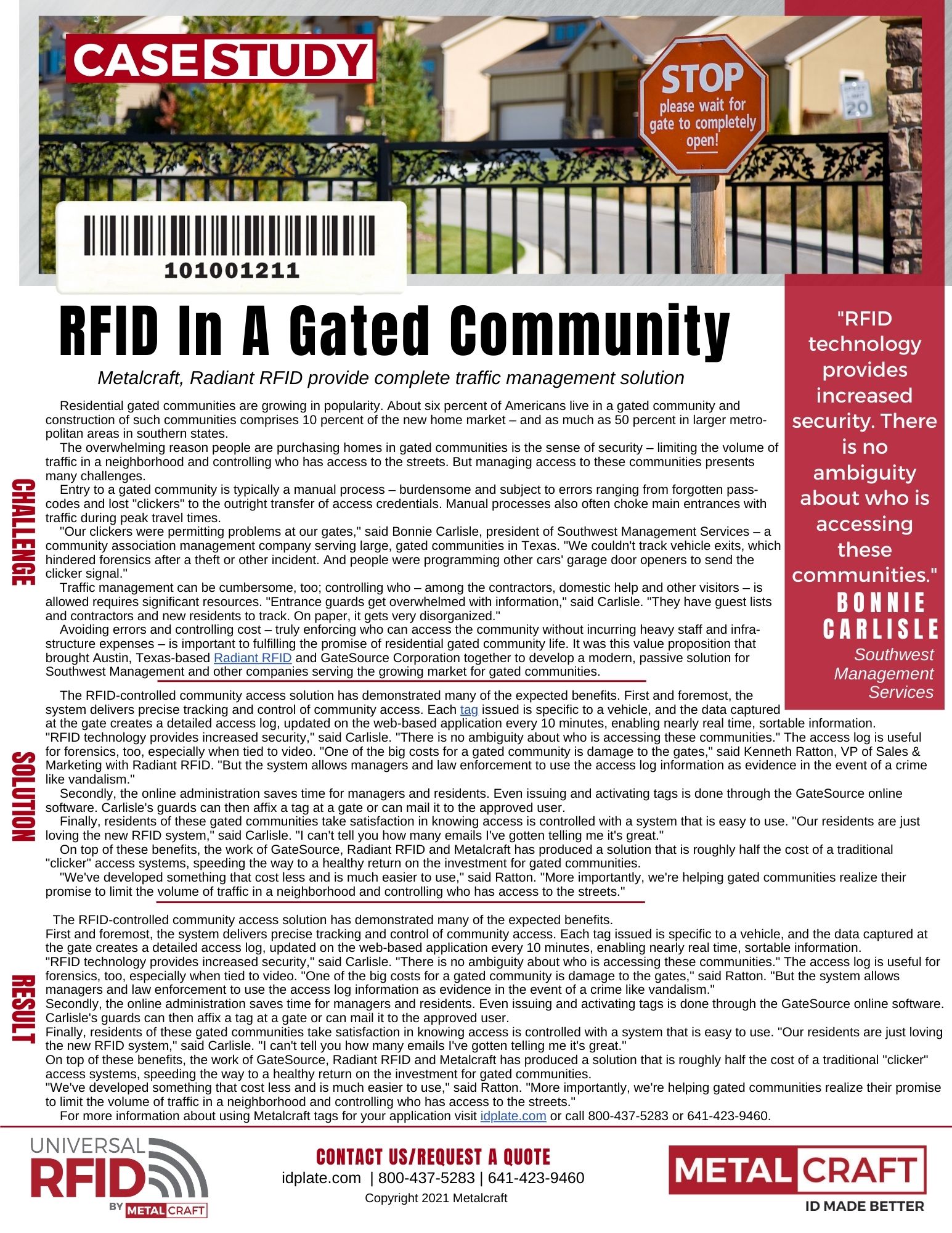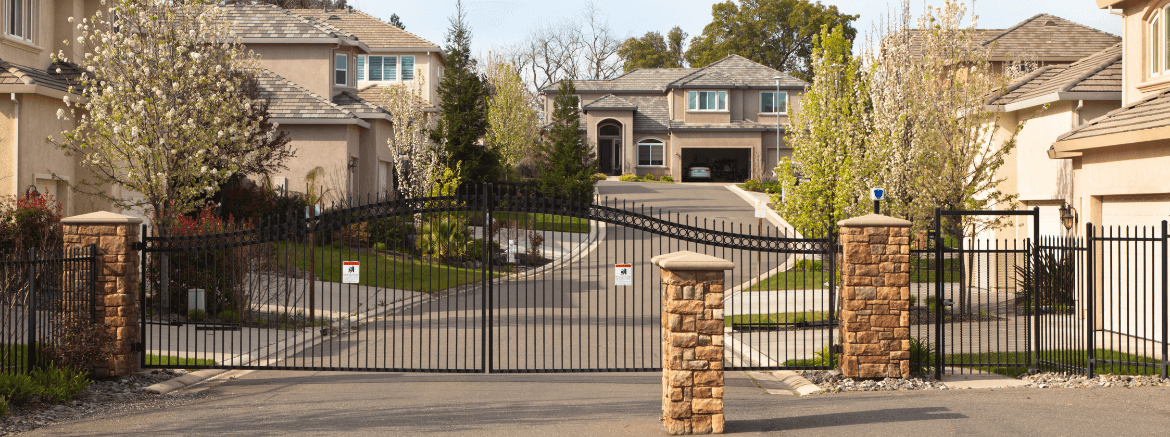Metalcraft, Radiant RFID provide complete traffic management solution
The Challenge
Residential gated communities are growing in popularity. About six percent of Americans live in a gated community and construction of such communities comprises 10 percent of the new home market – and as much as 50 percent in larger metropolitan areas in southern states.

The overwhelming reason people are purchasing homes in gated communities is the sense of security – limiting the volume of traffic in a neighborhood and controlling who has access to the streets. But managing access to these communities presents many challenges.
Entry to a gated community is typically a manual process – burdensome and subject to errors ranging from forgotten passcodes and lost "clickers" to the outright transfer of access credentials. Manual processes also often choke main entrances with traffic during peak travel times.
"Our clickers were permitting problems at our gates," said Bonnie Carlisle, president of Southwest Management Services – a community association management company serving large, gated communities in Texas. "We couldn't track vehicle exits, which hindered forensics after a theft or other incident. And people were programming other cars' garage door openers to send the clicker signal."
Traffic management can be cumbersome, too; controlling who – among the contractors, domestic help and other visitors – is allowed requires significant resources. "Entrance guards get overwhelmed with information," said Carlisle. "They have guest lists and contractors and new residents to track. On paper, it gets very disorganized."
Avoiding errors and controlling cost – truly enforcing who can access the community without incurring heavy staff and infrastructure expenses – is important to fulfilling the promise of residential gated community life. It was this value proposition that brought Austin, Texas-based Radiant RFID and GateSource Corporation together to develop a modern, passive solution for Southwest Management and other companies serving the growing market for gated communities.
The Solution
GateSource offers a web-based application that provides immediate and precise data exchange between security guards, property owners and administrators – "self-service" software for all users throughout the community. It eliminated the security staff's administrative burden of logging and updating resident information – the relationships between properties, occupants, guests, vehicles and gate credentials.
But GateSource was relying on old 'clicker' technology for gate authentication, opening exposure to the aforementioned access control challenges. "GateSource's web-based application fixed many problems for us," said Carlisle. "But RFID was the missing link."
Radiant RFID brought their expertise in RFID integration to bear, connecting the data on the backend of the GateSource software to an RFID-controlled system for points of community entry. Radiant RFID's system communicates via Web services to validate tags and assign rules to readers and gates.
"We built a simple but effective handshake that ties the RFID system to GateSource," said Kenneth Ratton, VP of Sales & Marketing with Radiant RFID. "We've never had any downtime with this system, and it requires zero maintenance."
The RFID system uses an interrogator antenna at the gate to read the passive, vehicle-mounted RFID tag and match the tag number against a database of permissible entrants. Valid tag numbers lift the gate automatically.
While the system is a relatively simple design, getting RFID tags that will perform in the wide range of vehicles and weather conditions was a challenge. "The tags have to hold up to the Texas heat," said Kenny Ratton. "Temperatures inside cars parked outside are outrageous in the summer."
Radiant RFID turned to Metalcraft for help with engineering an RFID tag that would fit the requirements for gated communities.
Metalcraft, an expert in the design and manufacturing of custom, durable ID products, sandwiched the Gen2 inlays between thin layers of polyester, adding human readable printing to one side and a windshield-compatible adhesive to the other.
"Metalcraft did a lot of testing to make sure the tag could read through auto glass at the proper distance," said Metalcraft president Steve Doerfler. "Our engineers tested many different inlay samples and substrates to come up with just the right combination." "Metalcraft's tag design has worked very well in its initial deployments at gated communities in Texas," said Ratton.
The Result
The RFID-controlled community access solution has demonstrated many of the expected benefits.
First and foremost, the system delivers precise tracking and control of community access. Each tag issued is specific to a vehicle, and the data captured at the gate creates a detailed access log, updated on the web-based application every 10 minutes, enabling nearly real time, sortable information.
"RFID technology provides increased security," said Carlisle. "There is no ambiguity about who is accessing these communities." The access log is useful for forensics, too, especially when tied to video. "One of the big costs for a gated community is damage to the gates," said Ratton. "But the system allows managers and law enforcement to use the access log information as evidence in the event of a crime like vandalism."
Secondly, the online administration saves time for managers and residents. Even issuing and activating tags is done through the GateSource online software. Carlisle's guards can then affix a tag at a gate or can mail it to the approved user.
Finally, residents of these gated communities take satisfaction in knowing access is controlled with a system that is easy to use. "Our residents are just loving the new RFID system," said Carlisle. "I can't tell you how many emails I've gotten telling me it's great."
On top of these benefits, the work of GateSource, Radiant RFID and Metalcraft has produced a solution that is roughly half the cost of a traditional "clicker" access systems, speeding the way to a healthy return on the investment for gated communities.
"We've developed something that cost less and is much easier to use," said Ratton. "More importantly, we're helping gated communities realize their promise to limit the volume of traffic in a neighborhood and controlling who has access to the streets."
To learn more about our asset tracking solutions, contact us today at [email protected].
